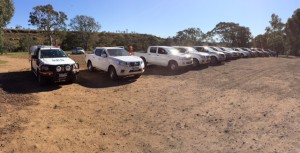4WD Off Road Evaluation
 Recently I got the opportunity to participate in a vehicle evaluation and test drive of a group of 11 current (September 2015) 4WDs on the market down at the Werribee 4WD training complex west of Melbourne. Got to say, it was pretty much a perfect day for me but it was also a bit of an eye opener in terms of what is available on the market and the capabilities of the current crop of Dual Cab utes.
Recently I got the opportunity to participate in a vehicle evaluation and test drive of a group of 11 current (September 2015) 4WDs on the market down at the Werribee 4WD training complex west of Melbourne. Got to say, it was pretty much a perfect day for me but it was also a bit of an eye opener in terms of what is available on the market and the capabilities of the current crop of Dual Cab utes.
To preface, we were looking at these from the standpoint that they would be used by people who would have done a 4WD course but would not necessarily do a lot of 4WDing otherwise, so the vehicles had to be practical, comfortable and easy to operate as well as safe. So rather than go hard core at the various obstacles, we tried to see if the technology allowed us to drive off road slowly and safely.
In these circumstances, the key considerations were ease of operating the 4wd system, effectiveness of the traction control systems, and the ability of the hill decent control or low range downhill gearing to control decent speeds.
Other considerations were performance with 3 or more passengers on board and ride comfort when traversing rough ground.
The results were surprising and certainly raised the eyebrows of many of the testers there.
The set course was fairly representative of what most of these vehicles would be expected to traverse under 90% of off road situations. It consisted of a heavily rutted track with very deep offset holes either side, a long muddy bog hole up to sill depth, a rocky and muddy mogul run, short dirt road, more rutted muddy tracks, a steep decent (about 45 degree) and a steep incline with offset deep wheel ruts to test articulation, and traction control and hill decent control (HDC) if fitted.
The vehicles were a Navara, BT50, Triton, Hilux x2, DMax, Colorado ute and wagon, Pajero, Prado and a VW Amarok. All were automatic and 4 cylinder turbo diesels (except the BT50 which was the 5 cyl).
All the vehicles handled the first section pretty easily. Some rode better than others over the rough track. The Navara stood out as having the best ride of all the utes and felt the most substantial. The Hilux and the BT-50 really shook us around. The three wagons were the most comfortable and less fussed. Separating them would be difficult. The Pajero is limited off road by comparison to the other two but its rear diff lock got it through in the end.
The hills were where we got the biggest shock. The Prado and Colorado wagons walked up and down without any fuss. Both had good rear wheel articulation and effective low range gearing and HDC. Neither activated their traction control on the uphill section even at less than walking pace. The Pajero was decidedly scary downhill. With no HDC, it ran away without brakes. Under attempted controlled braking, it locked up and skidded all the way down. Uphill, it hesitated about halfway up but the traction control kicked in and it made it up without too much more fuss. We purposely left the rear diff lock off on the hills. If it was engaged, it would have walked up easily.
Of the utes, the Hilux needed a fair bit of speed to get up. Otherwise it lost traction and slid backwards alarmingly, unable to make it up. Its traction control just doesn’t seem to work very well at all. Downhill it was brilliant with good low range gearing making up for not having HDC. The BT50 also struggled up the hill mainly because its traction control seemed a bit slow to kick in. It did regain traction and made it up but it was not without issue. Downhill was good with HDC activated. In fairness the BT50 was a tray back and had no load in the back. If it was the ute, it may have faired a bit better. All the other vehicles walked up and down the hills with no issues.
The biggest surprise was the Amarock. It does not have low range gearing but does have HDC and Traction control, both of which are extremely effective. It was so good, I tried everything to make it loose traction on the uphill section by almost idling it up, but nothing would stop it. Its an amazing vehicle with capabilities beyond expectation.
Another interesting observation was the seating positions and drivability of each vehicle. Most had seat height adjustment so getting a good off road driving position was possible. The BT50s seat was way too low for serious off road work. The Hilux (SR5) was terrible. Just couldn’t get a comfortable seating position. The Pajero and Colorado wagons were great. The Prado the biggest inside with the most room. If this was about interior comfort alone, you’d buy the Prado and be done with it..!
The operation of the transmissions was also interesting. Most have a sport shift mode with a gear up and down position. Most had the upshift (+) to the front of the car and the downshift (-) to the rear. This seemed the logical way and worked well. The BT50 is the opposite and we were constantly selecting the wrong gear as a result. Its just not logical. If you owned one and drove it all the time, you would get used to it. But jumping into it and other vehicles on the day was irritating to say the least.
Shifting into 4WD is also interesting depending on the Vehicle. The Amarok has no low range so you just put it into the lowest gear, push on the ‘off road’ button which engages the HDC and off you go. Most with a dial to select either 2H, 4H or 4L had to be put into neutral before they would change to low range. A couple of testers got caught out by this not realising they had not actually selected low range. You’ve got to read the manual these days apparently…! Getting the Prado into ‘off road mode’ takes some thinking about. The number of options and variations is mind boggling. Gone are the days of shifting into low range, making sure your hubs are locked and off you go…!
The other problem with autos is some have a mind of their own. The Colorados and DMax behaved exactly as they should, shifting up and down when ‘told’ to. Toyota boxes changed down easily enough but they tended to ignore upshifts until they were ready to change up depending on the speed. It was a bit annoying especially if you wanted to lope over obstacles without bouncing the accelerator. Fortunately, Toyota make decent long travel accelerators so its not so much a issue, just annoying.
I could not complain about any of the engines. All were good in their own ways and all could be left to pretty much idle over difficult terrain. The BT50’s 5 pot has so much torque down low, you just put it into 3rd and it will do most stuff with little throttle input. It does make a horrible noise when pushed though. Sounds like a bear having its toenails pulled out. Its not a high revving engine either. Where all the 4 pots like a bit of revving, the BT50 feels reluctant to spin up and its out of puff really early. Its not a bad thing, its just a different driving style to what I was used to.
The Amarok’s had the smallest engine of the group but it didn’t feel like it suffered for it. In fact its probably the nicest ute of the lot to drive. The Navara was not far behind.
In all, I wouldn’t say I wouldn’t be happy with any of the vehicles if I was given one. But if I had to put my hard earned towards one, purely on this test alone, I’d buy a Prado or the Colorado in the wagons. For the utes, I’d go for either the Amarok, Navara or the DMax.
Biggest surprise of the day was the Amarok. It is not a hard core off roader but its the safest and most comfortable ute in all conditions. And any idiot can get behind the wheel and take it almost anywhere with just the push of a button. If I had to buy a ute, it would be hard to pass up.

